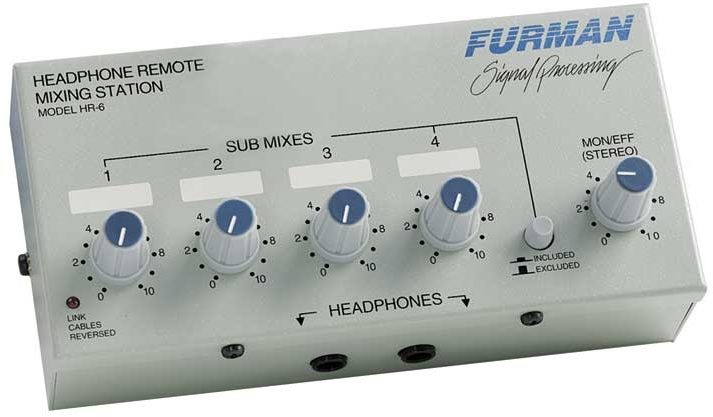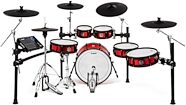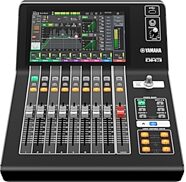Furman HR6 Headphone Remote Mixing Station
No longer available at zZounds


Portable mixing station from Furman is the best way to provide your musicians, or your self with quality mixes right where you need it most.
Overview
The HR-6 is a compact 6-channel, 5-pot remote mixer that clamps to any mic stand. When used with the HDS-6, the HR-6 allows musicians to customize their own headphone or monitor mix, and the engineer doesn't have to touch the board.
The HR-6 provides 4 mono pots and one stereo pot. The 4 mono pots allow each user to create a custom mix of 4 console channels or busses. The stereo pot will most often be used for a main control room mix, or for a stereo effects return.
The HR-6 also provides a "Submixes Included/Excluded" button, which mutes the four mono pots, allowing only the stereo source to be heard, without having to alter the HR-6's 4 monaural settings.
The HDS-6/HR-6 Audio Distribution System and HR-6 Remote Mixer are designed for high-end audio applications, yet are affordable enough for home studios and general live sound applications.
Features
Every performer in a studio or live sound setting can have a personalized mix without any adjustments at the board.
Perfect for use as a headphone system in the studio, plus drives powered monitors in live sound applications.
HDS-6 rackmount audio distribution system connects to the mixer/console to provide interface and power supplies to drive a group.
HR-6 remote mixer provides each musician with 5 volume controls: 4 monaural (for mixer channels or busses), plus one for an overall stereo mix or a stereo effects return.
HDS-6 to HR-6 linking cables are included with the HR-6, as is a universal mic stand clamp.
HDS-6 provides… read more gain trims and overload LEDs for each input, ground lift and on/off switch, and system status LEDs. read less
The HR-6 provides 4 mono pots and one stereo pot. The 4 mono pots allow each user to create a custom mix of 4 console channels or busses. The stereo pot will most often be used for a main control room mix, or for a stereo effects return.
The HR-6 also provides a "Submixes Included/Excluded" button, which mutes the four mono pots, allowing only the stereo source to be heard, without having to alter the HR-6's 4 monaural settings.
The HDS-6/HR-6 Audio Distribution System and HR-6 Remote Mixer are designed for high-end audio applications, yet are affordable enough for home studios and general live sound applications.
Features
Every performer in a studio or live sound setting can have a personalized mix without any adjustments at the board.
Perfect for use as a headphone system in the studio, plus drives powered monitors in live sound applications.
HDS-6 rackmount audio distribution system connects to the mixer/console to provide interface and power supplies to drive a group.
HR-6 remote mixer provides each musician with 5 volume controls: 4 monaural (for mixer channels or busses), plus one for an overall stereo mix or a stereo effects return.
HDS-6 to HR-6 linking cables are included with the HR-6, as is a universal mic stand clamp.
HDS-6 provides… read more gain trims and overload LEDs for each input, ground lift and on/off switch, and system status LEDs. read less
Specs
Input Impedance: 20K ohms
Sensitivity: Variable, -10 to +4 dBu for rated output (adjustable with trimpot on each input)
Power Output: 400 mW at 32 ohms (200 mW at 600 ohms, 500 mW at 100 ohms) from 20 Hz to 20 KHz
Inputs: RJ-45 jacks. Output: 1/4" stereo headphone jack
Connecting Cable: 2 each: 10Base-T UTP Ethernet computer cables, Cat. 3 or better
Distortion: 0.008% THD at full rated power at 1 KHz; 0.05% THD 20Hz to 20 KHz
Dynamic Range: Greater than 96 dB
Frequency Response: +0, -1 dB from 20 Hz to 20 KHz, 400 mW output
Power Requirement: 120 VAC, 60 Hz, 20 watts
Dimensions (H x W x D): 2.5 x 6.75 x 3.5 in.
Weight: 0.58 kg (1.25 lbs.)
Sensitivity: Variable, -10 to +4 dBu for rated output (adjustable with trimpot on each input)
Power Output: 400 mW at 32 ohms (200 mW at 600 ohms, 500 mW at 100 ohms) from 20 Hz to 20 KHz
Inputs: RJ-45 jacks. Output: 1/4" stereo headphone jack
Connecting Cable: 2 each: 10Base-T UTP Ethernet computer cables, Cat. 3 or better
Distortion: 0.008% THD at full rated power at 1 KHz; 0.05% THD 20Hz to 20 KHz
Dynamic Range: Greater than 96 dB
Frequency Response: +0, -1 dB from 20 Hz to 20 KHz, 400 mW output
Power Requirement: 120 VAC, 60 Hz, 20 watts
Dimensions (H x W x D): 2.5 x 6.75 x 3.5 in.
Weight: 0.58 kg (1.25 lbs.)
Reviews
Reviewers gave this product an overall rating of 4.5 out of 5 stars.
(11 ratings)
Submitted March 26, 2010 by a customer from gmail.com
"A great solution for live, practice, and studio monitoring."
Verified Customer
zZounds has verified that this reviewer made a purchase from us.
This review has been selected by our experts as particularly helpful.
Random Thoughts:
I love that is uses standard CAT-5 UTP cabling. Our practice space is wired up with a centralized telecom-style 66-block distribution panel, and CAT-5e runs to wall plates. Each wall plate has gray and blue jacks to match the cable color coding system Furman uses. I probably wouldn't have bought this system if I had to use XLR, TRS, or proprietary cables. Ethernet cable is easy to make yourself in custom lengths, cheap, ubiquitous...
The boxes are the right size. Not too big and bulky, not so small they'll get lost.
Alright, this is supposed to be just a review of the HR-6, but since you can't use this box without the HDS-6 rack unit, I have two complaints there: First, I'd like to see a headphone output on the HDS-6. It would make troubleshooting much easier, since the only feedback you get is a single power LED, and clip LEDs on the five inputs.
Also, I really hate the hard-wired power cord. I took mine apart, relocated the power transformer to the side, and put in an IEC inlet jack on the rear panel. Absolutely, totally, worth the trouble and voided warranty. It should have been made that way. Seriously.
I see myself using these until it becomes more practical to have someone mixing monitor feeds FOR us. Even then, I'm sure I'll find uses for them.
You won't get excited putting cash into this product, but you'll be really glad to have it.
Someone recently visited our practice space and was just awestruck at how much…
read more
easier it is to play when everyone can hear themselves, and everyone else. Not to mention, my ears don't bleed when we're out playing live.
Sound
I haven't ever noticed a difference in sound between my mixer's headphone output and any of the four HR-6s in use at the moment. There's a tiny bit of bleed between channels, but that's not surprising with several tens of feet of parallel unshielded cabling, and isn't in the least bit troublesome per our needs.
Features
There are six inputs: Two are for a stereo pair, and four are individual mono feeds. You can adjust the levels independently for all five (1*S and 4*M) sources. You can also disable the four mono feeds entirely, thereby "soloing" the stereo feed. This is useful, for example, if you use the stereo feed as a main mix, and the four mono feeds as "more me" channels. Now, the nice thing is that this box is dead simple to use. Musicians aren't always a technical bunch. Even with one button and five knobs, I sometimes have to remind everyone which knob does what (there is a spot for labels, if you're so inclined), but I rarely have to walk anyone through how to use it. That said, I would really REALLY like to see a master volume knob. Preferably, one for each or the two headphone outputs. Even better still, I'd love to be able to pan the mono feeds. The usefulness of the individual inputs is somewhat lost when everything is dead center in your phones. If stereo sound is important to you (or your users), you have to put all those sources in your main mix feed. But then you lose the ability to control their relative levels at the box. It's a trade-off, and I still struggle with which is the better option... stereo sound, or level control... hmm... If there were pan pots, you'd be able to chose between 1*S and 4*M, 3*S, or 2*S and 2*M. That would add a ton of versatility.
Ease of Use
From the users' perspective, this is a 10. From the engineer's perspective, it's a 9, since it lacks a few "essential" features. Overall, it's simple, to-the-point, and intuitive. Absolutely the best option in this price range.
Quality
I bought my system in stages. Some of them were used, most new. All of them are subject to regular abuse, and work pretty well despite that. They ship with high-strength velcro to mount the box to the mic stand adaptor. This has worn out on a few of them. The adhesive has worn out on one. Some of them stick together TOO well, and I've bent a stand adaptor trying to take the box off. On a couple, the pots aren't perfectly smooth, but the sonic performance doesn't seem to be any worse for the wear. I broke a knob off (along with most of the pot shaft) on one of the boxes after it fell four feet to the floor (due to the worn-out velcro...) The pot still works fine, you just have to be a little creative to use it. I think every one of the boxes has taken at least a couple dives though, so one casualty is easily excused. I don't worry about road worthiness. They may not be pretty after a couple years of use, but they'll still get you through the gig.
Value
Yeah, absolutely a value for the money. The Aviom, Hear, etc., stuff is all way too expensive for working musicians, or a project studio or whatever. This system has a bit of an entry fee, since you need the HDS-6 and at least two HR-6s to be of much use, but I haven't found a cheaper way to get this level of flexibility. I've looked. Naturally, I'd like to see the boxes a little cheaper, but the price is reasonable for the build quality and durability. If there had to be sacrifices to shave $20 or $50 off, I'd rather pay their present going rate instead.
Manufacturer Support
Haven't needed support on these, but I spoke with a support rep regarding a Furman pedal board, and they were very helpful. Someday I'll get that knob fixed...
The Wow Factor
Not sexy, really. It's a beige box. Digital interconnects (for single-cable hookup, for example), more channel options (pan pots, limiting, etc.) would all increase the salivation rating, but probably also the cost and complexity. This gets.. the job.. DONE. Good enough.
Musical Background:
Active musician, amateur engineer
Musical Style:
Rock, acoustic, electronic read less
Sound
I haven't ever noticed a difference in sound between my mixer's headphone output and any of the four HR-6s in use at the moment. There's a tiny bit of bleed between channels, but that's not surprising with several tens of feet of parallel unshielded cabling, and isn't in the least bit troublesome per our needs.
Features
There are six inputs: Two are for a stereo pair, and four are individual mono feeds. You can adjust the levels independently for all five (1*S and 4*M) sources. You can also disable the four mono feeds entirely, thereby "soloing" the stereo feed. This is useful, for example, if you use the stereo feed as a main mix, and the four mono feeds as "more me" channels. Now, the nice thing is that this box is dead simple to use. Musicians aren't always a technical bunch. Even with one button and five knobs, I sometimes have to remind everyone which knob does what (there is a spot for labels, if you're so inclined), but I rarely have to walk anyone through how to use it. That said, I would really REALLY like to see a master volume knob. Preferably, one for each or the two headphone outputs. Even better still, I'd love to be able to pan the mono feeds. The usefulness of the individual inputs is somewhat lost when everything is dead center in your phones. If stereo sound is important to you (or your users), you have to put all those sources in your main mix feed. But then you lose the ability to control their relative levels at the box. It's a trade-off, and I still struggle with which is the better option... stereo sound, or level control... hmm... If there were pan pots, you'd be able to chose between 1*S and 4*M, 3*S, or 2*S and 2*M. That would add a ton of versatility.
Ease of Use
From the users' perspective, this is a 10. From the engineer's perspective, it's a 9, since it lacks a few "essential" features. Overall, it's simple, to-the-point, and intuitive. Absolutely the best option in this price range.
Quality
I bought my system in stages. Some of them were used, most new. All of them are subject to regular abuse, and work pretty well despite that. They ship with high-strength velcro to mount the box to the mic stand adaptor. This has worn out on a few of them. The adhesive has worn out on one. Some of them stick together TOO well, and I've bent a stand adaptor trying to take the box off. On a couple, the pots aren't perfectly smooth, but the sonic performance doesn't seem to be any worse for the wear. I broke a knob off (along with most of the pot shaft) on one of the boxes after it fell four feet to the floor (due to the worn-out velcro...) The pot still works fine, you just have to be a little creative to use it. I think every one of the boxes has taken at least a couple dives though, so one casualty is easily excused. I don't worry about road worthiness. They may not be pretty after a couple years of use, but they'll still get you through the gig.
Value
Yeah, absolutely a value for the money. The Aviom, Hear, etc., stuff is all way too expensive for working musicians, or a project studio or whatever. This system has a bit of an entry fee, since you need the HDS-6 and at least two HR-6s to be of much use, but I haven't found a cheaper way to get this level of flexibility. I've looked. Naturally, I'd like to see the boxes a little cheaper, but the price is reasonable for the build quality and durability. If there had to be sacrifices to shave $20 or $50 off, I'd rather pay their present going rate instead.
Manufacturer Support
Haven't needed support on these, but I spoke with a support rep regarding a Furman pedal board, and they were very helpful. Someday I'll get that knob fixed...
The Wow Factor
Not sexy, really. It's a beige box. Digital interconnects (for single-cable hookup, for example), more channel options (pan pots, limiting, etc.) would all increase the salivation rating, but probably also the cost and complexity. This gets.. the job.. DONE. Good enough.
Musical Background:
Active musician, amateur engineer
Musical Style:
Rock, acoustic, electronic read less
13 of 14 people (93%) people found this review helpful. Did you?
Thanks for your opinion!
No longer available at zZounds
In most cases, a product is unavailable because it has been discontinued by the manufacturer
This is a carousel with product cards. Use the previous and next buttons to navigate.











